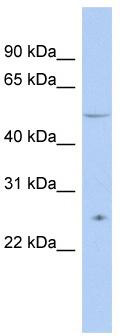TTC8 Rabbit Polyclonal Antibody
Frequently bought together (3)
Recombinant protein of human tetratricopeptide repeat domain 8 (TTC8), transcript variant 2, 20 µg
USD 867.00
Transient overexpression lysate of tetratricopeptide repeat domain 8 (TTC8), transcript variant 2
USD 436.00
Other products for "TTC8"
Specifications
| Product Data | |
| Applications | WB |
| Recommended Dilution | WB |
| Reactivities | Human |
| Host | Rabbit |
| Isotype | IgG |
| Clonality | Polyclonal |
| Immunogen | The immunogen for anti-TTC8 antibody: synthetic peptide directed towards the N terminal of human TTC8. Synthetic peptide located within the following region: ENAIAQVPRPGTSLKLPGTNQTGGPSQAVRPITQAGRPITGFLRPSTQSG |
| Formulation | Liquid. Purified antibody supplied in 1x PBS buffer with 0.09% (w/v) sodium azide and 2% sucrose. |
| Purification | Affinity Purified |
| Conjugation | Unconjugated |
| Storage | Store at -20°C as received. |
| Stability | Stable for 12 months from date of receipt. |
| Predicted Protein Size | 54 kDa |
| Gene Name | tetratricopeptide repeat domain 8 |
| Database Link | |
| Background | The BBSome complex is required for ciliogenesis but is dispensable for centriolar satellite function. This ciliogenic function is mediated in part by the Rab8 GDP/GTP exchange factor, which localizes to the basal body and contacts the BBSome. Rab8(GTP) enters the primary cilium and promotes extension of the ciliary membrane. Firstly the BBSome associates with the ciliary membrane and binds to Rabin8, the guanosyl exchange factor (GEF) for Rab8 and then the Rab8-GTP localizes to the cilium and promotes docking and fusion of carrier vesicles to the base of the ciliary membrane.This gene encodes a protein that has been directly linked to Bardet-Biedl syndrome. The primary features of this syndrome include retinal dystrophy, obesity, polydactyly, renal abnormalities and learning disabilities. Experimentation in non-human eukaryotes suggests that this gene is expressed in ciliated cells and that it is involved in the formation of cilia. Alternate transcriptional splice variants have been characterized. |
| Synonyms | BBS8; RP51 |
| Note | Rat: 100%; Human: 100%; Dog: 93%; Pig: 93%; Mouse: 93%; Bovine: 93%; Guinea pig: 93%; Horse: 86%; Rabbit: 86% |
| Reference Data | |
Documents
| Product Manuals |
| FAQs |
| SDS |
{0} Product Review(s)
0 Product Review(s)
Submit review
Be the first one to submit a review
Product Citations
*Delivery time may vary from web posted schedule. Occasional delays may occur due to unforeseen
complexities in the preparation of your product. International customers may expect an additional 1-2 weeks
in shipping.






























































































































































































































































 Germany
Germany
 Japan
Japan
 United Kingdom
United Kingdom
 China
China



